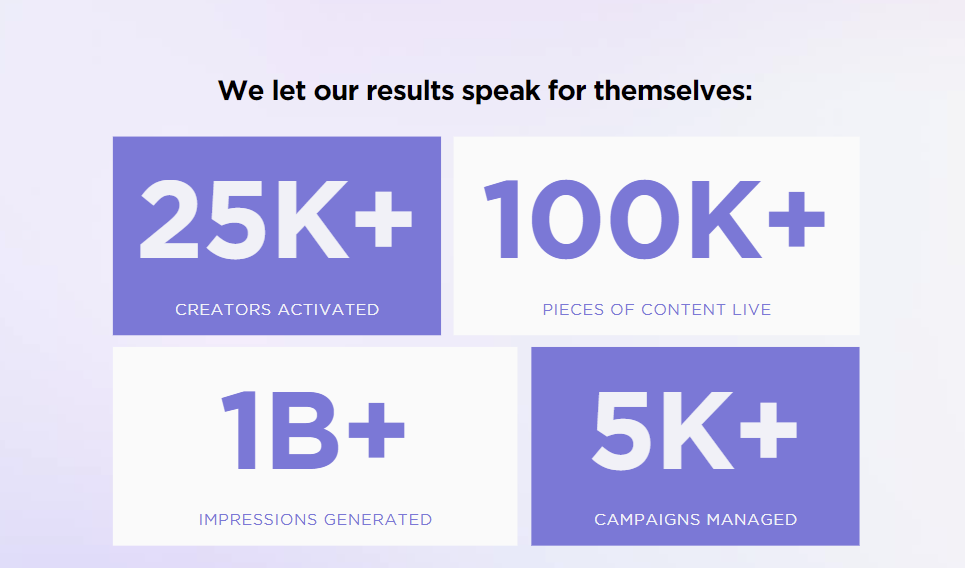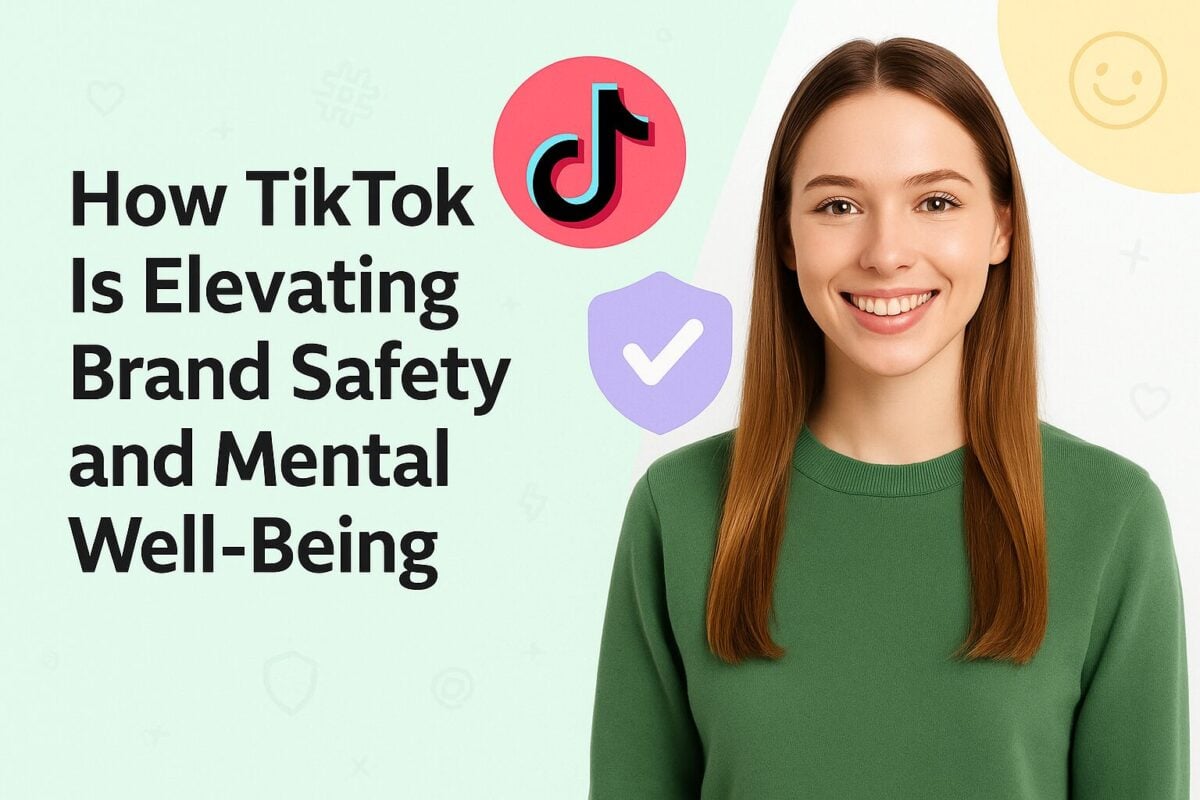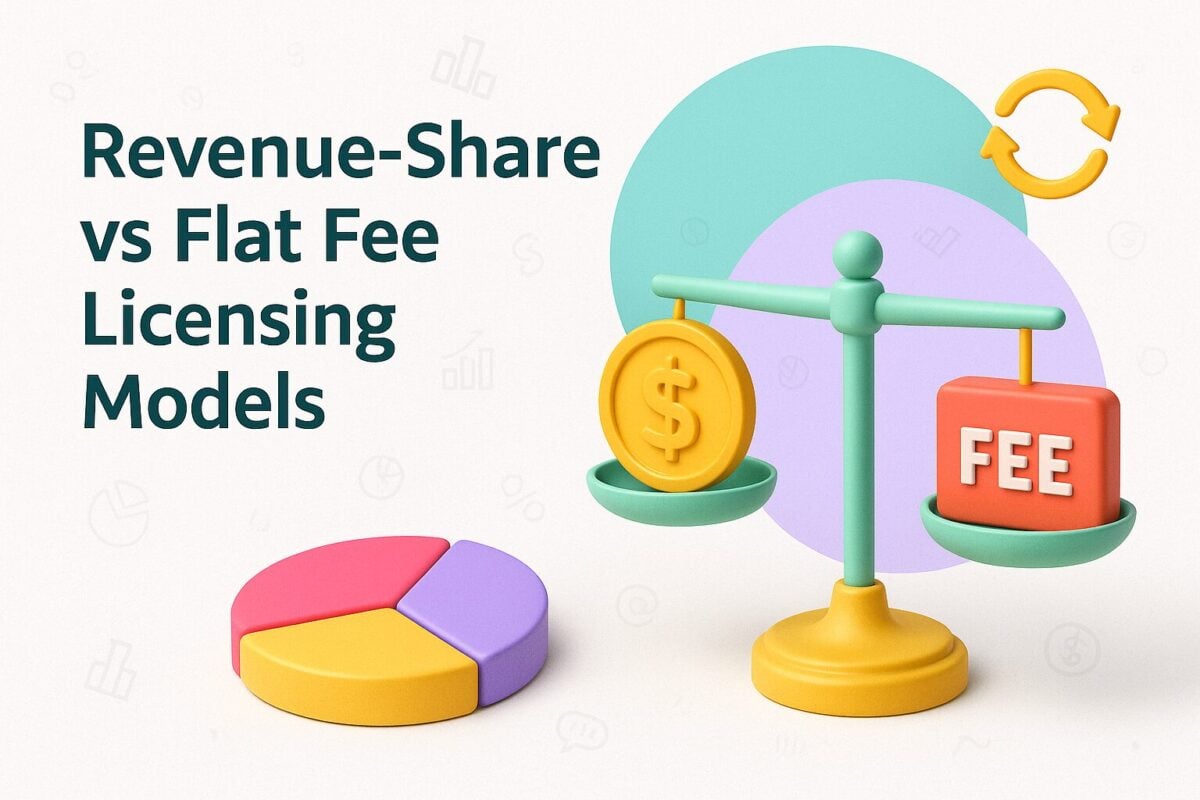The global influencer market has grown tremendously since 2019, now worth over $21 billion this year compared to $16.4 billion in 2022. This growth has been paralleled by the evolution and expansion of influencer marketing platforms, which have become crucial tools in connecting brands with the right creators.
New trends have arisen as more avid social media users become creators, essential players in the creator economy. Influencer marketing and user-generated content are front and center, while traditional marketing techniques, once go-to strategies, have taken a back seat in an economy run by rising creators.
Methodology
With a multitude of responses from anonymous creators, this creator economy report aims to analyze creator economy trends to predict future trends. With the help of NeoReach, a longstanding and active contributor to the creator economy, it’s time to unravel new trends, challenges, and opinions by the creators who define the landscape!
NeoReach conducted and distributed a time-sensitive survey to gather information on the creator economy, creator monetization, sentiments toward generating income as a creator, and other statistics that help predict future trends in the creator economy.
Over 2,000 creators were surveyed to compile sufficient data to properly analyze these trends. The following report does not include all creator data for sponsored content and other creator monetization options. However, the data presented comes from diverse creators, from small, part-time creators to larger, full-time creators with veteran-level experience.
As the creator economy continues to shift, we hope the conclusions gathered will better represent the state of the creator economy while also showcasing creator-earning power and monetary success. Quotes presented throughout the report will showcase personal anecdotes from anonymous creators.
At a Glance
Before we dive in, let's highlight some statistics on the creator ecosystem:
- The creator economy is expected to generate $480 billion in revenue by 2027, the fastest growing sub-industry within digital media.
- Out of our 2,000 surveyed creators, 44.9% identify as full-time creators, roughly 900 total, up 10% from last year.
- Over 300 part-time creators make between $2,500 - $5,000 per month.
- 92% of creators earn most of their revenue through brand deals.
- Tech and business creators are the top niches that earn over $150,000 per year.
- Over 10% of surveyed creators have started their own creator-led brand.
- 5% of creators measure personal success through engagement rates, 32.5% measure through income, and 9% measure through their follower counts.
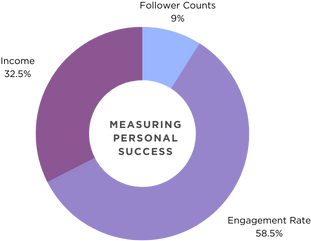
Creator Earnings Analysis
The creator economy is not just about numbers; it's about the people behind those numbers. By understanding which age groups are the power players and where they spend their time, we can better tailor strategies, content, and collaborations to resonate with the right audience.
This section delves deep into the rich data collected from our expansive survey of creators. Our aim? To provide a granular understanding of the multifaceted aspects of creator earnings. Here's what you can expect:

Audience Demographics
Discover who's tuning in. From millennials to Gen Z, get a clear picture of the diverse audience that engages with content across various platforms.
Age Demographics Across Platforms
Not all platforms are created equal. Some resonate more with younger audiences, while others have a more mature user base. Uncover which age groups dominate each social media platform, offering insights into where creators might find their most engaged audience.
Primary Social Media Platforms
In the vast sea of social media, where are creators primarily casting their nets? Understand the platforms that are the top choices for creators when it comes to posting and engaging with their audience.
Audience Demographics
An overwhelming majority of creators are adults between 25 and 34, although young and middle-aged adults have significant prominence in the creator economy.
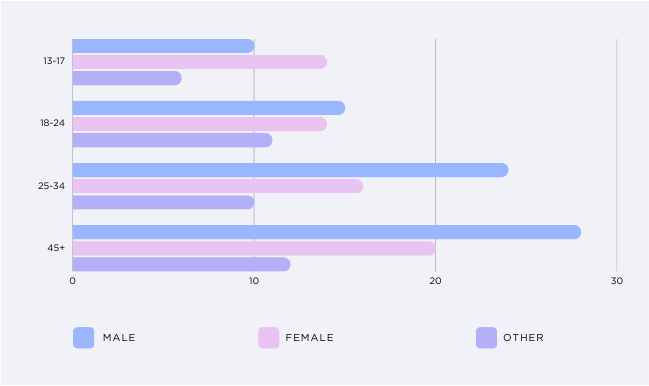
These statistics suggest that veteran creators can influence how younger creators promote and create content.
Most of our surveyed creators attended college, and most did not drop out to pursue careers in content creation.
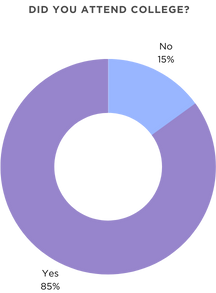
Nearly 85% of creators did not drop out for unrelated reasons, though those who did drop out left within 1-2 years of education. College dropout rates peak during freshman year, so our data aligns with standard dropout rates.
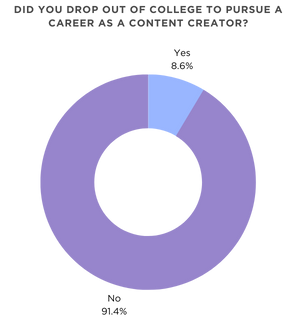
However, not all surveyed creators dropped out of content creation, though financial pressures could have heavily influenced their decision. Amateur creators who are new to influencing could have decided to be part-time creators during their years in college.
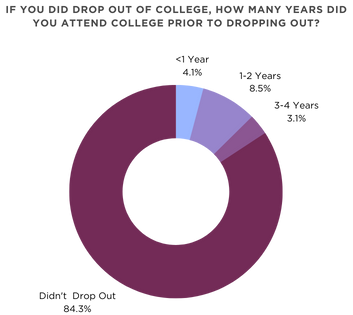
Part-time and full-time creator statistics will be analyzed later in this report to better determine if these college creators started as part-time creators or began their journey post-graduation.
Social Channels
Each social media platform accommodates creators based on their niches, interests, and preferences.
Our results concluded that creators will prefer some platforms over others depending on one’s niche and targeted demographic. However, devoted creators will make their presence known on multiple platforms to maximize their reach and engagement.
Primary Social Channels Used by Creators
Instagram’s legacy as a long-standing platform suggests that creators have higher engagement than TikTok. However, these stats hint that creators typically post on multiple platforms instead of sticking to one.
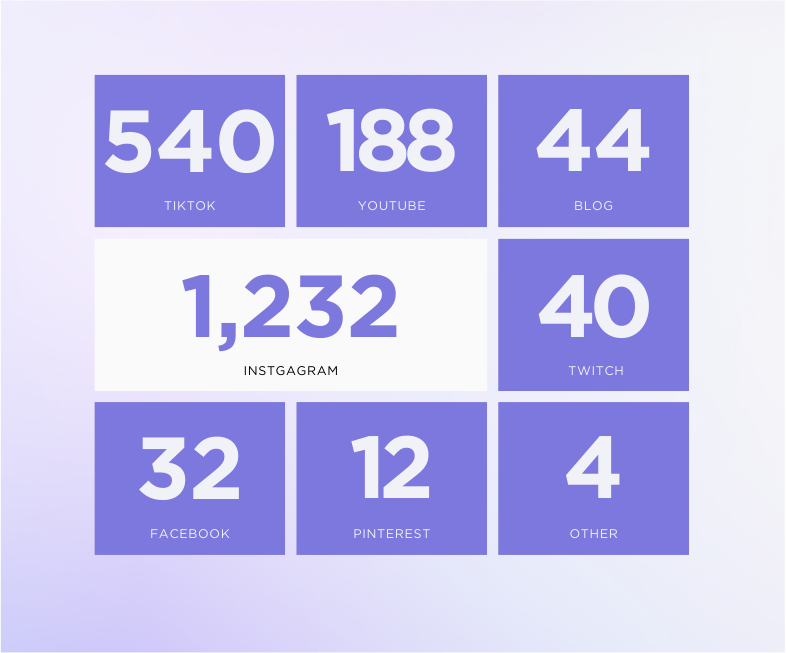
Social Media Spread Across Ages
Young adults lean toward platforms like Instagram, TikTok, YouTube, and Twitch, while older creators prefer Facebook, Pinterest, and blogging. However, ages between 25 and 34 prefer diversifying their presence on multiple platforms.

A Deep Dive into Creator Careers
Every person has a reason for becoming a creator. Some desire to touch people's hearts with uplifting content, while others want to foster a community of people with the same interests as them. Likewise, some people become creators to have another side hustle to prioritize making money.
Whatever the reason, these creators have a purpose in the economy and deserve to have their voices recognized.
Creator Niches
People can live a happy, healthy lifestyle in multiple ways, making “Lifestyle” a popular niche in the creator economy.
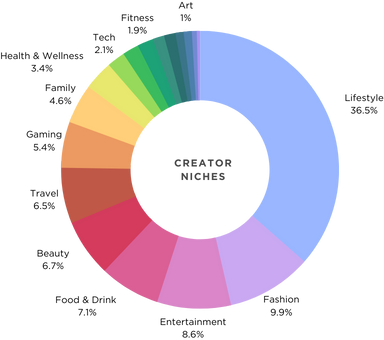
Unsurprisingly, “Lifestyle” surpasses other niches because it’s an umbrella category for fashion, family, entertainment, and beauty. Likewise, categories like “Fitness” and “Health & Wellness” are often intertwined because of content similarities.
The consensus is that versatile categories are more popular amongst creators. However, it’s important to note that participants can interpret each category differently, furthering their likelihood of picking a less specific niche.
What Matters Most to Creators?
Every creator has their aspirations and goals they want to achieve during their careers. We asked our creators what mattered most when creating content: generating income, connecting with others, or building a community. We received an array of answers that helped encompass the perseverance and determination in the creator space.

How Do You Measure Personal Success as a Creator?
Our surveyed creators measure success through their engagement.
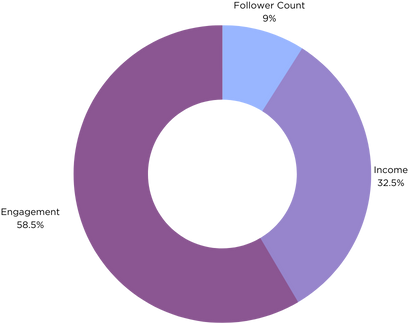
Unlike follower count, engagement better encapsulates the value of a creator’s content and ability to connect with their community. Better engagement attracts brands, making it easier for creators to receive sponsorships, which, in turn, generates income.
It’s important to acknowledge that income allows creators to continue creating, so over 32% of our surveyed creators measure success through their income. If creators value their success through their income and engagement, brands must properly compensate these creators.
Full-Time vs. Part-Time Creators
Over 68% of our surveyed creators have been creators for over three years, making them prominent economic leaders.

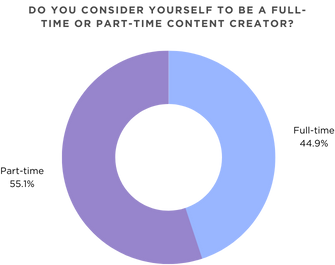
Our surveyed creators were predominantly veteran creators with three or more years of experience.
A notable result is that the split between part-time and full-time careers is quite balanced. This statistic suggests that creators consider going full-time later in their careers.
Although it’s unclear how many hours these creators dedicate their careers weekly, we can safely assume that full-time is anything over 40 hours per week, while part-time is below 40.
How Long Have You Been a Content Creator?
The survey results suggest that new creators typically start as part-time creators, but veteran creators become full-time after four years. These results suggest that as creators gain more experience, they commit more time to content creation and fostering their community.
Veteran creators who understand how the creator economy and social media landscape functions dominate the survey. Knowledge in this landscape influences a creator’s confidence in their ability to be successful as a full-time creator.
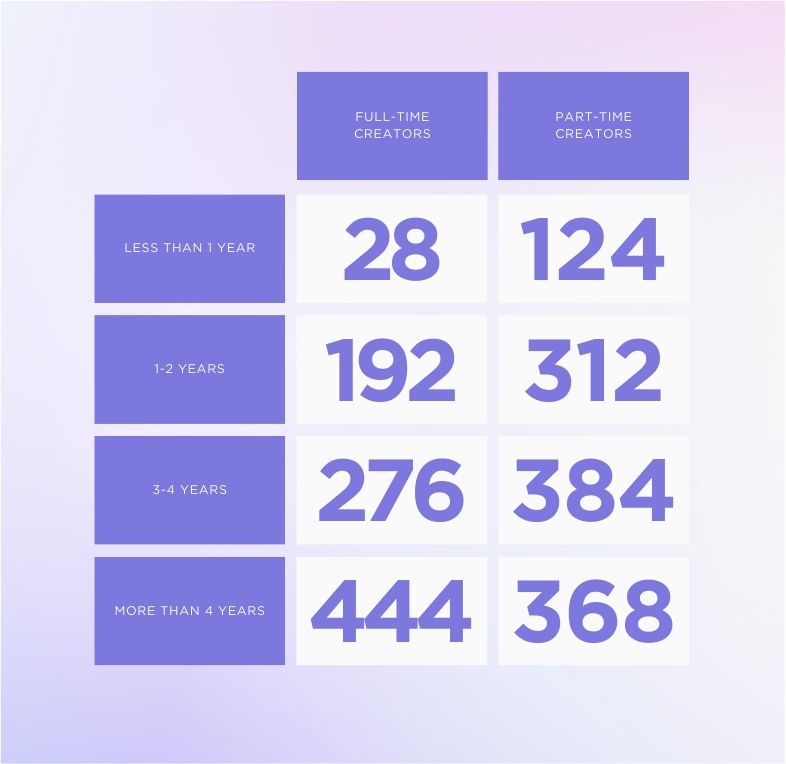
Creator Earnings
Creator earnings are heavily influenced by a multitude of factors: a creator’s niche, gender, hours dedicated to content creation, revenue source, and desired platform.
In these next slides, we will dissect what platforms generate the most revenue for creators and where these sources of income come from. In addition, we will acknowledge some key statistics that will help predict the future of the creator economy.

Estimated Annual Earnings
Lifestyle” and “fashion,” the most popular categories, do not guarantee high annual incomes. These results suggest that saturated niches are more competitive and less lucrative, like “tech” and “business.” However, “Food & Drink,” a relatively popular category, has higher annual earnings based on the creator’s audience.
Annual Income
Over 48% of our surveyed creators earn $15,000 or less.
Despite the near 50-50 split between part-time and full-time creators, nearly half of the surveyed creators generate an annual income of $15,000 or less.
The second and third most saturated annual income categories are $50k-75k (10.6%) and $15-25k (9.3%). These results suggest that part-time creators earn less than their full-time counterparts.
However, it’s important to note that some full-time creators may earn as much as part-timers, while some part-timers may earn more than full-timers. What determines higher income is not full or part-time status -- it’s the creator’s demographic, niche, and commitment to developing relations with businesses and brands.
In addition, creators who obtain sponsorships and partnerships will have a higher annual income than those who opt out of those opportunities.
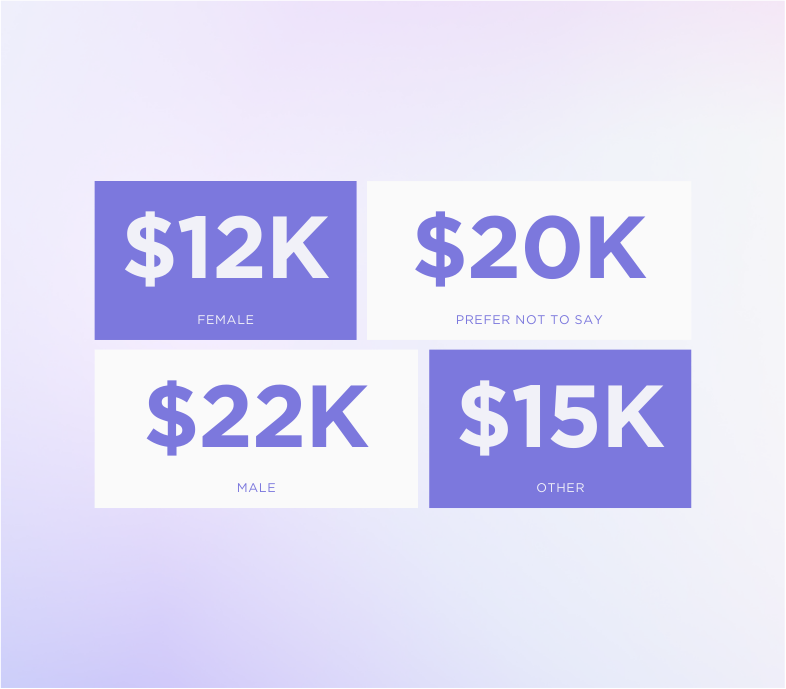
Annual Income
Survey results recognize a drastic pay discrepancy between men and women while other genders fall in between the two medians. However, most creators receive an annual income below $15,000, with a small spike in the $50k-75k range. These results conclude that a gender pay gap exists, though a creator’s niche can impact annual income.
What Would It Take to Become a Full-Time Creator?
We asked creators how much they would like to earn to pursue a full-time creator career. Over 300 creators would like to earn 5k-7.5k per month. However, nearly 300 participants are comfortable with being paid 2.5k to 5k monthly.
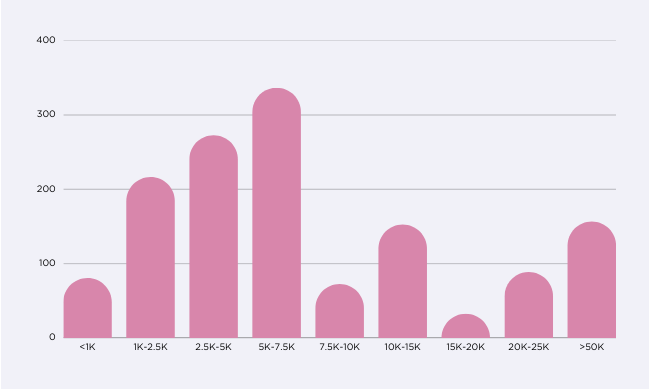
Revenue Source
Over 66% of surveyed creators earn most of their revenue from brand deals.
Not only do creators earn most of their revenue through brand deals, but they also want to receive most of their income through deals. These results suggest that fostering healthy relations with brands guarantees stable earnings and potential partnerships with brands in the future.
Brand partnerships might also encourage creators to kickstart brands, which persuades other creators to seek partnerships with creator-owned brands.
In addition, creators want to earn more ad share revenue. These statistics suggest that creators want more creator-run platforms where middle-men businesses don’t take large sums of their revenue. Platforms like OnlyFans and Kick have just revenue splits between businesses and creators, which has attracted creators to their sites.
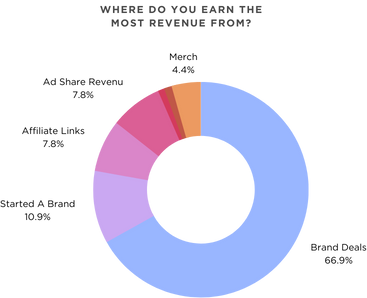
Monetized Channels
Affiliate programs and sponsorships make up a majority of a creator’s income. Although TikTok and Instagram are go-to platforms, creators receive less income through those channels than on YouTube, a rising star for short-form, long-form, and streaming content. TikTok creators earn even less than Twitch, Pinterest, and Snapchat.
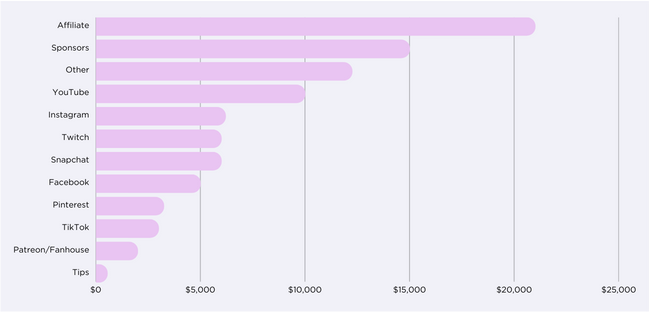
Sponsored Posts
Last year, over 44% of our surveyed creators created between 0 and 10 sponsored posts, while 20.6% have created 10-20 and 17% have created 20-30. Another notable result is that the sponsored post max pay and median max pay are vastly different. These differing numbers suggest businesses base their pay on a creator’s reach, following, engagement, and prevalence in their respective niches.
However, we will discover later in this report that many creators have expressed their dissatisfaction between businesses because of the amount they are being paid per post and partnership.
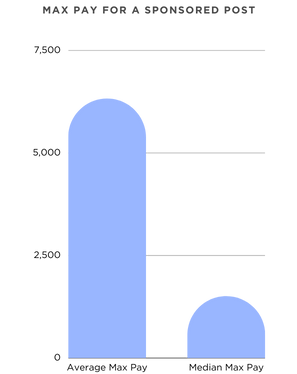
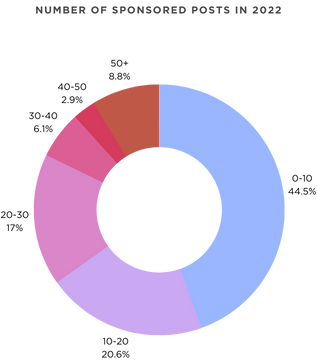
Types of Campaigns
Our surveyed creators prefer traditional marketing campaigns, although gifting and experiential (engagement) campaigns.
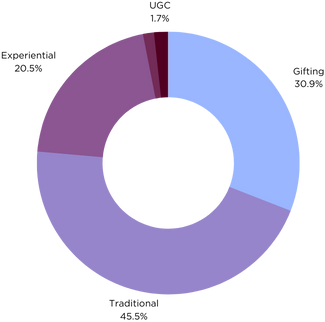
Affiliate campaigns are less popular because they lack the incentives that traditional, experiential, and gifting campaigns provide. UGC campaigns are relatively new, so as brands and businesses utilize UGC creators, time will only tell whether or not these campaigns will become preferred.
For brands seeking creators for campaigns, remember to compensate creators, whether it be with products, services, or money.
Creator Services
Over 54% of creators use services like Capcut, Adobe, and Canva.
Easy-to-learn and accessible programs such as Capcut, Adobe, Canva, and InShot are preferred services and tools for creators. Likewise, platforms that provide users with photo/video editing capabilities are popular among creators.
However, editing-specific programs such as Splice, VidIQ, and Final Cut Pro are lesser-known services creators use. These results suggest that tight creator budgets make these programs less accessible.
These results suggest that creators with limited access to expensive computers and equipment find Capcut, Adobe, and Canva more desirable for content creation.
From Creator’s POV
Surveyed creators received opportunities to respond to open-ended questions about creator economy trends, hardships, aspirations, and feel-good moments as creators.
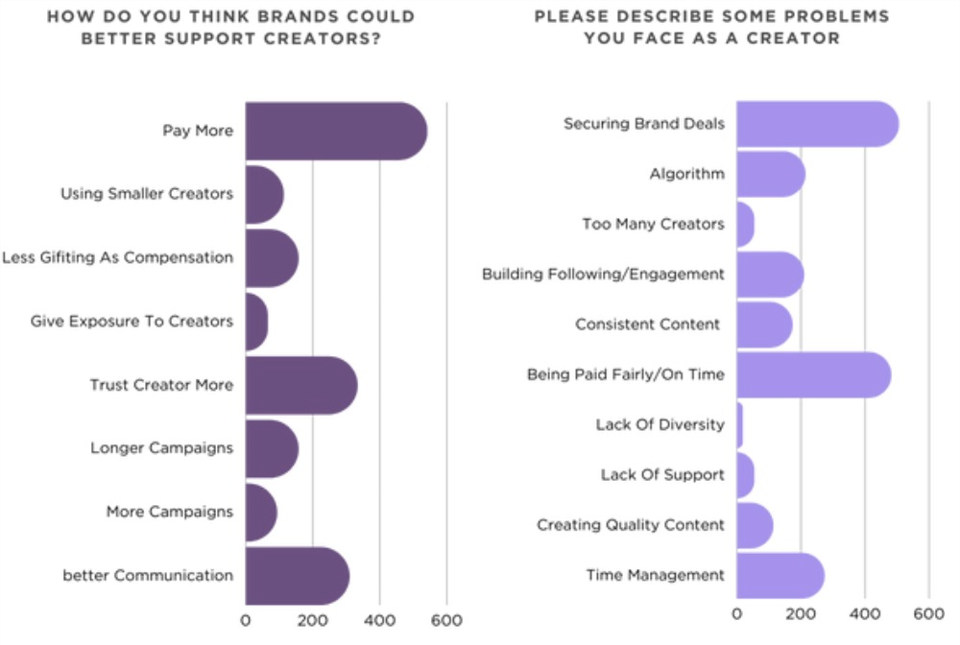
These questions help better understand the thoughts of these creators and how these power-players will continue to impact the creator economy. These responses will remain anonymous to ensure privacy.
Brand Support & Problems
Creators influence industry trends, news, and future predictions, but creators have expressed concerns about what sorts of problems hold them back from achieving their goals. Most creators have expressed their distaste for wages, payment times, and securing brand deals, especially as small creators.
To maintain the health of the creator economy, businesses must accommodate and adapt to creator needs to ensure that marketing campaigns and creators can have equal success. In addition, bridging the gap between brands and creators will allow for stronger partnerships and referrals for other creators and businesses.
“What are some trends you're currently seeing in the Creator Economy?”
Dozens of creators have recognized that User-Generated Content is “is taking off more” and “making a big splash” within the creator economy. Others acknowledge an “uprising in UGC vs influencer sponsored content.”
- A few surveyed creators have addressed that “authenticity” is a rising trend. One creator responded that content is shifting from “materialistic, self-absorbed, mindless consumption” to “authentic and sustainable.”
One creator stated that creators are becoming key players and believe creators are becoming founders and are “gaining power in the media ecosystem.”
- One positive trend is that “more and more creators are starting to realize how valuable they are for brands and marketing in general.” In addition, this creator believes that creator communities trust their favorite influencers.
- However, another creator believes that creators are “working a lot for free” for very low rates, which suggests that although creator voices are more valued, brands continue to pay them unfairly.
- Another anonymous contributor believes brands are “turning more to creators” and ditching “traditional advertising methods.”
“Please describe some problems you face as a creator”
Notable trends in these responses conclude that many creators believe that being paid on time and receiving fair wages are some of the biggest issues with being a creator. Others have stated that “finding paid work” is a struggle, especially when kickstarting creator careers.
- Another problem creators face is finding brand deals that mesh well with their content, many believing they “have potential” and deserve suitable deals.
- Smaller creators are unsure on “how to get sponsored brand deals,” which suggests that affiliate programs are the few ways for smaller creators to get involved.
- One creator felt like AAA brands undervalued their work, starkly contrasting with other surveyed creators believing their voices are more impactful in the creator economy.
- An anonymous creator believes “Brands who think they can only get results from mega influencers” is a huge issue. They listed other problems such as, “lack of in-app monetization opportunities” and “brands who undercut creators and creators who undercut themselves.”
Several surveyed creators are transparent about their beliefs that being a creator can cause burnout and negatively impact their mental health. These setbacks contribute to many creators losing their income.
- “It's easy to get discouraged and lost when it comes to keeping up with trends. The constant need to post and always be on is draining. Because it's our career and also our escape, I never truly get a break. If I'm not online, I'm not working, I'm not earning money. It's hard to find a way to take a break without feeling like I'm going to lose money.”
“Please describe your favorite parts about being a content creator”
Several creators expressed gratitude for being able to have a flexible schedule. Creators love having control of their craft and not having anyone stop them.
Other creators love the community-building aspect of having an online presence on their favorite platforms. Creators who find like-minded individuals who love what they love make their journey as a creator more fulfilling.
- “I work full-time in the pharmaceutical industry, and I run a candle business on the side. I write for my blog when I have time, and I also am working on a couple of novels that I hope to publish within the next 5 to 10 years. I love to read and stay active and I’m looking for ways to incorporate the things I love into my content to share and connect with others.”
- “I love sharing my home and decor with my audience, and giving them a discount code on things that I know they will appreciate! Teaching my audience things through DIY is also fun, while sharing the transformations of my home!”
- “Flexibility. I have too much to do but if the kids need me I can usually drop everything to be with them and then pick back up after they go to sleep or postpone. I don't wait until the last minute for sponsorships so meeting those deadlines and being there for my kids is never an issue.”
- “Connecting with millions of people, making connections with creators and learning from each other, the opportunities to work with huge brands, travel for work on tourism jobs and the ability to be outside and it be a part of my job.”
- “I love meeting new people and interacting with brands and followers. I love to be able to use my creativity and have it be appreciated by both the brands and the viewers!”
Key Takeaways
- Creators seek monetization opportunities through affiliate programs and sponsorships. However, creators feel they need to be more appreciated and desire better wages for their work.
- Technology and Business are the most lucrative industries for creators. These categories are not oversaturated and have a healthy level of competition between creators.
- Instagram and TikTok are powerhouse platforms for creators to engage and grow.
- Female creators dominate the ecosystem yet receive less annual income than other genders.
- Veteran creators who have influenced for three years or more also dominate the creator economy.
- Most creators want to create authentic, high-quality content to better connect with their audience.
Future Predictions
- As newbie creators traverse their way through a creator-driven economy, devoted creators will feel confident in becoming full-time.
- User-generated content will become more popular and sought after by brands and businesses.
- Creators who desire brand deals will continue searching or start their own brands, primarily focusing on attracting creators like them.
- Both brands and creators will seek out influencers who value authenticity and honesty.
- Creators will experiment in niche content categories to stand out in a saturated and competitive market. In addition, creators will expand their online presence to multiple social media platforms.
- Creators will consider promoting themselves on platforms where they believe they will receive on-time payments and fair wages for their work. Some platforms include OnlyFans, Kick, and Patreon.
